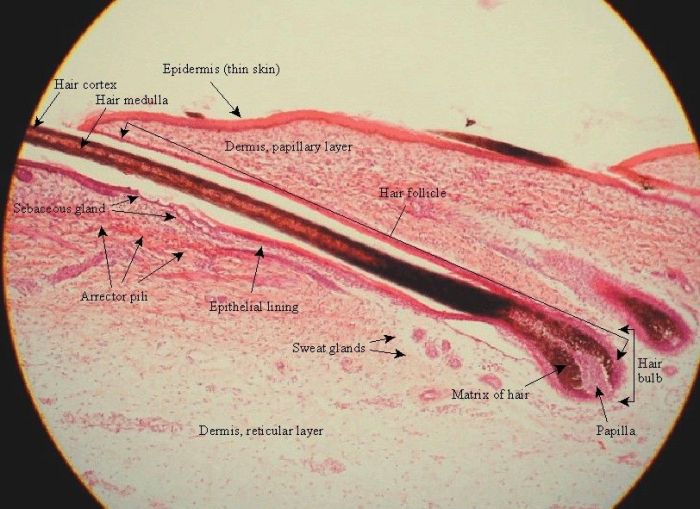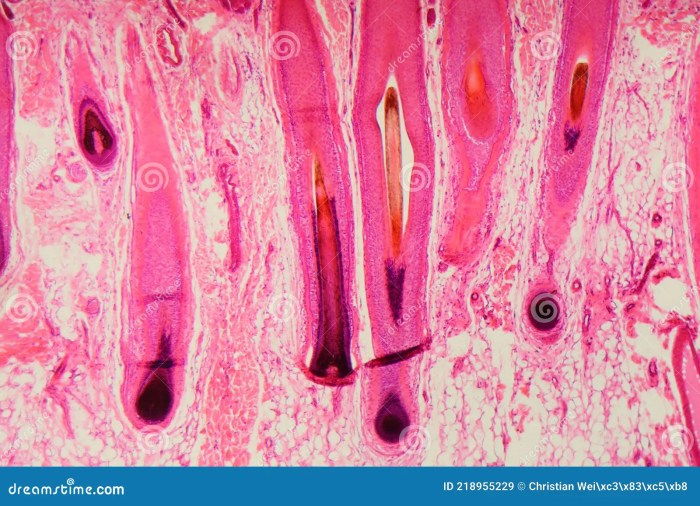Hair follicle under microscope labeled – Unveiling the intricate world of hair follicles, this article delves into their microscopic structure, growth cycle, common disorders, and cutting-edge research, providing a comprehensive understanding of these vital hair-producing units.
Hair follicles, the intricate structures responsible for hair growth, are composed of multiple layers, including the shaft, root, and bulb. Each layer harbors specialized cell types with distinct functions, orchestrating the growth and maintenance of healthy hair.
Hair Follicle Structure

Hair follicles are complex structures that produce hair. They are located in the skin and consist of several layers, including the shaft, root, and bulb.The shaft is the visible part of the hair that extends above the skin’s surface. It is made up of keratin, a tough protein that protects the hair from damage.The
root is the part of the hair follicle that is located below the skin’s surface. It contains the hair bulb, which is responsible for producing new hair.The bulb is the base of the hair follicle. It contains stem cells that divide and produce new hair cells.
Hair Growth Cycle
Hair growth occurs in a cyclical pattern that consists of three phases: anagen, catagen, and telogen.The anagen phase is the active growth phase. During this phase, the hair follicle produces a new hair shaft.The catagen phase is a transitional phase.
During this phase, the hair follicle shrinks and the hair shaft is pushed out of the skin.The telogen phase is the resting phase. During this phase, the hair follicle remains dormant.
Hair Follicle Disorders
There are a number of hair follicle disorders that can cause hair loss or other problems. Some of the most common hair follicle disorders include:
- Alopecia is a condition that causes hair loss. There are many different types of alopecia, including androgenetic alopecia (male-pattern baldness) and alopecia areata (patchy hair loss).
- Hirsutism is a condition that causes excessive hair growth in women. It is often caused by hormonal imbalances.
- Trichotillomania is a condition that causes people to pull out their hair. It is a psychological disorder that can be very difficult to treat.
Hair Follicle Research, Hair follicle under microscope labeled
There is a great deal of research being conducted on hair follicles. This research is focused on understanding the mechanisms of hair growth and hair loss. The goal of this research is to develop new treatments for hair follicle disorders.Some
of the most promising areas of hair follicle research include:
Stem cell research
Stem cells are cells that have the ability to develop into any type of cell in the body. Researchers are studying the use of stem cells to grow new hair follicles.
Gene therapy
Gene therapy is a technique that involves introducing new genes into cells. Researchers are studying the use of gene therapy to treat hair follicle disorders.
Tissue engineering
Tissue engineering is a technique that involves creating new tissues from living cells. Researchers are studying the use of tissue engineering to create new hair follicles.
Hair Follicle Microscopic Images
 |
 |
 |
 |
Label:
- Shaft
- Root
- Bulb
- Dermal papilla
- Outer root sheath
- Inner root sheath
Clarifying Questions: Hair Follicle Under Microscope Labeled
What is the function of the hair follicle?
Hair follicles are responsible for producing and anchoring hair shafts, providing insulation, and contributing to skin health.
What are the different phases of the hair growth cycle?
The hair growth cycle consists of three phases: anagen (active growth), catagen (transitional), and telogen (resting).
What are some common hair follicle disorders?
Common hair follicle disorders include alopecia (hair loss), hirsutism (excessive hair growth), and trichotillomania (compulsive hair pulling).


